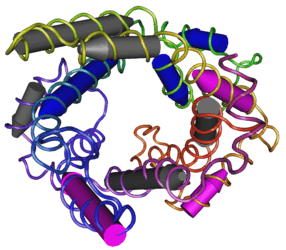Uncoupling protein

An uncoupling protein (UCP) is a mitochondrial inner membrane protein that is a regulated proton channel or transporter. An uncoupling protein is thus capable of dissipating the proton gradient generated by NADH-powered pumping of protons from the mitochondrial matrix to the mitochondrial intermembrane space. The energy lost in dissipating the proton gradient via UCPs is not used to do biochemical work. Instead, heat is generated. This is what links UCP to thermogenesis. UCPs are positioned in the same membrane as the ATP synthase, which is also a proton channel. The two proteins thus work in parallel with one generating heat and the other generating ATP from ADP and inorganic phosphate, the last step in oxidative phosphorylation.[1] Mitochondria respiration is coupled to ATP synthesis (ADP phosphorylation) but is regulated by UCPs.[2]
There are five types of homologs known in mammals:
- UCP1, also known as thermogenin
- UCP2
- UCP3
- SLC25A27, also known as "UCP4"
- SLC25A14, also known as "UCP5"
Uncoupling proteins play a role in normal physiology, as in cold exposure or hibernation, because the energy is used to generate heat (see thermogenesis) instead of producing ATP. Some plants species use the heat generated by uncoupling proteins for special purposes. Skunk cabbage, for example, keeps the temperature of its spikes as much as 20° higher than the environment, spreading odor and attracting insects that fertilize the flowers.[3] However, other substances, such as 2,4-dinitrophenol and carbonyl cyanide m-chlorophenyl hydrazone, also serve the same uncoupling function. Salicylic acid is also an uncoupling agent (chiefly in plants) and will decrease production of ATP and increase body temperature if taken in extreme excess.[4] Uncoupling proteins are increased by thyroid hormone, norepinephrine, epinephrine, and leptin.[5]
History
Scientists observed the thermogenic activity in brown adipose tissue, which eventually led to the discovery of the UCP. The brown tissue revealed elevated levels of mitochondria respiration and another respiration not coupled to ATP synthesis, which symbolized strong thermogenic activity.[2] The UCP was the protein discovered responsible for activating a proton pathway that was not coupled to ADP phosphorylation.[2]
References
- ↑ Nedergaard J, Ricquier D, Kozak LP (2005). "Uncoupling proteins: current status and therapeutic prospects". EMBO Rep. 6 (10): 917–21. doi:10.1038/sj.embor.7400532. PMC 1369193. PMID 16179945.
- 1 2 3 Rousset, Sophie; Alves-Guerra, Marie-Clotilde; Mozo, Julien; Miroux, Bruno; Cassard-Doulcier, Anne-Marie; Bouillaud, Frédéric; Ricquier, Daniel (2004-02-01). "The Biology of Mitochondrial Uncoupling Proteins". Diabetes. 53 (suppl 1): S130–S135. doi:10.2337/diabetes.53.2007.S130. ISSN 0012-1797. PMID 14749278.
- ↑ Garrett, Reginald H.; Grisham, Charles M. (2013). Biochemistry (Fifth Edition, International ed.). China: Mary Finch. p. 668. ISBN 978-1-133-10879-5.
- ↑ "California Poison Control System: Salicylates". Archived from the original on 2014-08-02.
- ↑ Gong DW, He Y, Karas M, Reitman M (1997). "Uncoupling protein-3 is a mediator of thermogenesis regulated by thyroid hormone, β3-adrenergic agonists, and leptin". J Biol Chem. 272 (39): 24129–32. doi:10.1074/jbc.272.39.24129. PMID 9305858.
External links
- Uncoupling+Agents at the US National Library of Medicine Medical Subject Headings (MeSH)